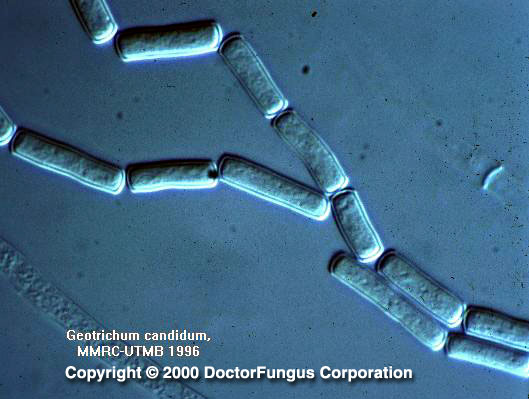(described by Link ex Persoon in 1822)
Taxonomic classification
Kingdom: Fungi
Phylum: Ascomycota
Subphylum: Ascomycotina
Order: Saccharomycetales
Family: Endomycetaceae
Genus: Geotrichum (Endomyces)

This image of Blastoschizomyces capitatus (obselete names of Trichosporon capitatum and Geotrichum capitatum) is included here for comparison purposes.
Description and Natural Habitats
Geotrichum is a yeast found worldwide in soil, water, air, and sewage, as well as in plants, cereals, and dairy products [301]. It is also found in normal human flora and is isolated from sputum and feces [1295, 2202].
Species
The genus Geotrichum includes several species. The most common one is Geotrichum candidum. Geotrichum clavatum and Geotrichum fici are among other Geotrichum species.
Geotrichum fici has an intense smell resembling that of pineapple [2202].
Synonyms
See the summary of synonyms and teleomorph-anamorph relations for the Geotrichum spp.
Pathogenicity, Clinical and Environmental Significance
As well as being a colonizer of the intestinal tract, Geotrichum spp. may cause opportunistic infections in immunocompromised host and these infections are referred to as geotrichosis. The infections are usually acquired via ingestion or inhalation. Bronchial and pulmonary as well as disseminated infections and fungemia due to Geotrichum have been reported. It has also been isolated from infections resulting from trauma [62, 332, 716, 753].
Apart from its clinical significance, there are very recent claims on environmental damages that Geotrichum might have caused ((E):go to article in the Telegraph). It has been blamed for destroying the aluminium and data-storing polycarbonate resin that are found in the structure of compact discs. This in turn led to discoloration of the disc, with the disc becoming partly transparent. The exact role of Geotrichum in this destruction process requires confirmation.
Macroscopic Features
Geotrichum strains produce rapidly growing, white, dry, powdery to cottony colonies, resembling “ground glass.” When disturbed on the surface, the colony becomes yeast-like or slimy. The optimal growth temperature is 25°C. Most strains either do not grow at all or grow weakly at 37°C [1295, 2202].
Microscopic Features
Arthroconidia and coarse true hyphae are observed. Blastoconidia, conidiophores and pseudohyphae are absent. Arthroconidia (6-12×3-6 µm) are unicellular, in chains, hyaline, and result from the fragmentation of undifferentiated hyphae by fission through double septa. They are either rectangular in shape or rounded at the ends resembling the barrel shape. Consecutive formation of arthroconidia and absence of empty cells that fragment to release arthroconidia (“disjunctor cells”) are typical [1295, 2202].
Histopathologic Features
Septate hyphae (3-6 µm wide) and rectangular to oval arthroconidia are observed in tissues infected with Geotrichum [462].
Compare to
Chrysosporium
(A):Coccidioides immitis
Malbranchea
Moniliella
Oidiodendron
Scytalidium
Trichosporon
Geotrichum differs from Scytalidium by having hyaline arthroconidia and from Arthrographis and Oidiodendron by lacking conidiophores. Unlike Malbranchea, Geotrichum produces arthroconidia by fission rather than by releasing them from disjunctor cells. While the arthroconidia of Coccidioides immitis alternate with empty cells, those of Geotrichum are consecutive. Unlike Trichosporon and Moniliella, Geotrichum lacks blastoconidia.
Laboratory Precautions
No special precautions other than general laboratory precautions are required.
Susceptibility
In vitro data on activity of antifungal agents against Geotrichum isolates are rather limited. Among the azoles, voriconazole yields the lowest MICs, followed by ketoconazole and itraconazole [2432]. While fluconazole yields very low MICs, some sordarin derivatives also show favorable activity against clinical Geotrichum isolates [1040, 1632].
For MICs of various antifungal drugs for Geotrichum, see our N/A(L):susceptibility database.
The standard therapeutic regimen for treatment of geotrichosis is not yet available. Amphotericin B with or without flucytosine could be considered as could itraconazole. However, prognosis of disseminated geotrichosis is usually poor, with a mortality rate as high as 75% [753].


